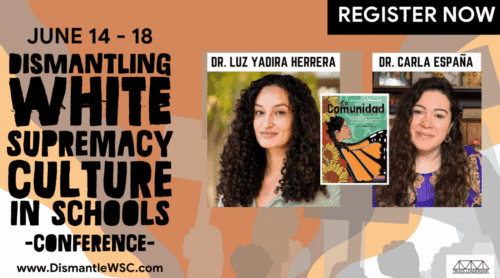How Do We Dismantle White Supremacy Culture? – An Interview with Luz Yadira Herrera & Carla España, Presenters at DWSC 2021
Find out how we dismantle white supremacy culture from Luz Yadira Herrera and Carla España, authors of “En Comunidad: Lessons for Centering the Voices and Experiences of Bilingual Latinx Students.”
Carla and Luz are two of our dope workshop presenters at the upcoming Dismantling White Supremacy Culture in Schools 2021 Conference June 14-18th. Read all the other presenter interviews here: Shane Safir & Jamila Dugan, Matthew Kay
Register for the DismantleWSC Conference here learn about our presenters below.
Interview with Luz Yadira Herrera & Carla España
What type of student were you and where did you find joy?
LYH: I was a shy and quiet student. I started school in the US in third grade and only spoke Spanish. I also didn’t have access to bilingual education. I grew up in California in the 90s, and during that time, CA had significant anti-immigrant policies like Prop 227, which dismantled bilingual education and Prop 187, which created a hostile environment for immigrant communities like mine. And even though this latter legislation was eventually reversed and deemed unconstitutional, the hostility remained, and if anything, it only spread across the entire nation. The broader socio-political forces certainly added stress to me as a young person and dwindled my confidence to speak up and assert myself. It changed around high school as I became more comfortable in this country and in myself.
Perhaps the most joy that I found was during our annual drives back home to Nayarit, Mexico. It took two whole days to get there by car, and when we were there, I finally felt free to be my entire self. It’s where I felt the most connected to myself, my family, the land, and my language. In the U.S., I felt I was just existing day-to-day, just trying to keep up with everyone else’s expectations.
CE: I came from Chile with my mom at the age of five to be reunited with my dad in New York City. Not understanding the school culture, confusion with instruction that was all in English, and dealing with the fear of deportation, made me turn inward and like Luz, I was quiet in school. There wasn’t a bilingual program at my elementary school at the time and the English as a Second Language program removed us “English Language Learners” from our classes for targeted instruction. I found joy in music classes, books that I’d borrow from my school’s library and my visits to our local public library in Queens. My mom would take me and I have vivid memories of reading there with her. It’s one of the reasons why I’m so moved by Yuyi Morales’ Dreamers/ Soñadores book too! On weekends I’d go to La Escuela Argentina, where instruction was in Spanish. I found joy there when I was singing, dancing, and participating in classes when I understood what was happening.
What is the most destructive force in schools?
LYH: Disconnect. Disconnect from each other (students – family/community – teachers – education leaders). Disconnect from the outside forces that disrupt our communities, and the lives of our students and their families. This can look like disassociating what is happening in the “outside” world from the classroom. Such as failing to create meaningful spaces for connection between harmful policies/events happening “outside” and students’ lives (which may profoundly impact and harm them).
CE: In Pedagogy of the Oppressed, Paulo Freire writes that “education is suffering from narration sickness.” I’m reminded of those words as I think of the many things we need to unlearn so we can rebuild. There’s this fear that accompanies any thoughts going beyond dominant structures, curriculum, texts, and the narratives around communities that have been marginalized. We see this with the ways Black and Brown bodies are viewed, in rates of detention and suspension (thank you Monique Morris for stellar work illuminating this), with the impact of standardized testing, the ways bilingual education will be welcomed or banned depending on who the programming is for, the struggle for ethnic studies, the reactions to #DisruptTexts, and so much more.
When we look across these examples of inequity we must ask ourselves about the root causes and name those. In my research, teaching, consulting, and life experience as a student across different institutions of learning, there always seems to be an unsettling that comes when systems of power are questioned. This is most common when disenfranchised communities seek more equitable practices.
As we return back to in-person learning, what should we prioritize?
LYH: We have to prioritize building connections with each other. In many places, kids haven’t seen each other in person for over a year. And they haven’t seen their teachers for just as long. We have been missing social connection and interaction, which can be critical in leading meaningful lives. Relationships should be our priority. We have to consider some key questions: How do we ensure a humanizing process to (re)connection? How do we make sure to authentically check in on each other? How do we create critical spaces to be vulnerable and learn from our experiences during this pandemic? To share in the loss and the lessons that we have all experienced. This pandemic is the one event that connects us all in one way or another. We might even share some moments of joy.
We have been living during a pandemic while white supremacist forces have been out in full effect in harming all of us (from children in cages at the border to George Floyd to violence against the AAPI community). We need to sit with ourselves, with each other, and take in, really SEE and experience, the fullness, the complexity, and the intersectionality of our identities and lived experiences. We need to heal through reconnecting.
CE: Those questions Luz asks are crucial. In En Comunidad: Lessons for Centering the Voices and Experiences of Bilingual Latinx Students, we talk about getting to know students and making sure we are processing our own experiences to notice what we are bringing with us to all learning spaces. As we return to in-person learning we must consider how our work brings together healing and teaching for critical consciousness. We can’t do one without the other. Finding out that the return to in-person schooling coincided with test preparation filled me with so much rage. We are still losing people to this pandemic, to racial injustice, to housing insecurity, homophobia, transphobia, and it is urgent that we teach the whole child. What are we doing with the precious time that we have to be in community?
Centering healing is necessary along with considering the issues of our day and understanding how historical movements shape the present moment. I’ve been in a book club with teachers this year reading Paul Ortiz’s An African American and Latinx History of the United States and our discussions have centered around the importance of coalition building to grow our solidarity. As a teacher returning to in-person learning I must keep this in mind, making sure that my pedagogy lives at the intersection of healing and critical conscious-raising approaches. Also, like Luz reminds us here and Gholdy Muhammad does in her culturally and historically responsive framework, we need joy.
When it gets hard, where do you find inspiration to continue fighting for justice?
LYH: I am the mother of a Black biracial 7-year-old boy. He is my most important teacher and source of inspiration. I am also the daughter of immigrants, a sister, a friend, and a partner. I have a tremendous sense of responsibility to dismantle systems of oppression that harm us. My son, my family, my friends, and my community uplift me and inspire me to continue to contribute toward dismantling white supremacy in education and everywhere else.
CE: I am grateful for the moments I’ve been having in my multigenerational home. My mom has always been a great storyteller and my dad is a wonderful listener who will surprise you with his humor. They’ve sacrificed a lot as immigrants, leaving Chile without having family in New York. For years I grew up seeing them helping everyone they could and their example inspires me to always be intentional with my talents, to seek more ways to be in service of others, and to love deeply. I’m also inspired by my husband’s thoughtfulness and the way he considers the students and staff at his middle school with his teaching and leadership decisions. Strengthening my connection with loved ones is really important to me as I continue in this struggle for justice.
What is the most exciting aspect of your work?
LYH: I get to teach future teachers and leaders. In one of my major roles, I direct a bilingual teacher residency program, and this means that I get to contribute to shaping the near future of bilingual education in my region and that is a true privilege.
In one of my classes this semester, I have 25 students. All bilingual Latina women (self-identified). How powerful is that? The sisterhood that we’ve been building because of this very unique classroom dynamic has been magical. We get to use our dynamic language practices during class without having to accommodate anyone. I get to be/see myself fully for the first time in a class, and several have shared a similar sentiment toward me. In some cases, I am the first Latina professor they’ve had. It has truly been the most liberating experience.
CE: I love the moments when this magical spark clicks for teachers and students in their teaching and learning journeys. Those times when they finally see themselves as writers, when their stories find a platform/audience, when they find that author they connect with, the book that makes them feel less alone, and the lessons that bridge the past with the present. Helping students make these connections in my work with middle grade teaching and teacher education programs is really moving. It’s exciting to see this mix of creativity, confidence, joy and renewed sense of purpose. It’s like that first time we watched that CBS interview with Marley Dias and learned of her #1000BlackGirlBooks campaign. That sense of wonder and purpose. That’s what’s exciting to me. To be involved in a teacher and students’ journey of connections with themselves and others.
What is your favorite book, song or movie of all time? Why?
LYH: I can’t identify one thing that is my favorite, that has always been hard for me…I would say one of my favorite albums of all time is The Miseducation of Lauryn Hill. It’s one of those works of genius that I can listen to from start to finish any day. The intros and outros. It came out in the late 90s when I became more in-tune with U.S. American culture and language; and it marked the beginning of my own consciousness-raising journey on the complexity of U.S. life, politics, and relationships to the land, society, and each other.
CE: I have to say that the book Braiding Sweetgrass: Indigenous Wisdom, Scientific Knowledge and the Teaching of Plants by Robin Wall Kimmerer has changed my life. I return to this text time after time as I continue to grow in my understanding of reciprocity in our relationship with the land, with one another, and our vocation. It’s given me a new lens for looking at my role as an educator and mother. It’s also one of my favorite mentor texts for my writing. It’s poetic and relational. It’s the healing balm and reminder to take care of myself as I seek to take care of those around me.
Register for the DismantleWSC Conference here
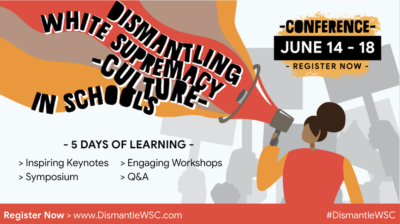
About Luz Yadira Herrera
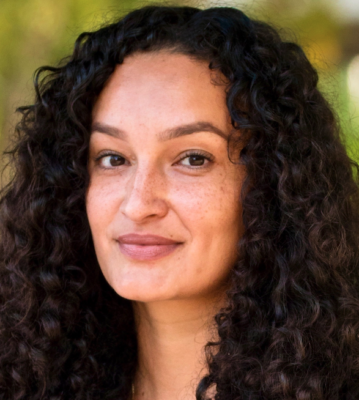 Luz Yadira Herrera, Ph.D. is a teacher, researcher, author, and co-founder of the En Comunidad Collective (encomunidadcollective.com). Dr. Herrera has over fifteen years of experience in the education of emergent bilinguals in both mainstream and bilingual settings. She is currently an Assistant Professor of Multilingual and Multicultural Education in the Kremen School of Education and Human Development at California State University, Fresno.
Luz Yadira Herrera, Ph.D. is a teacher, researcher, author, and co-founder of the En Comunidad Collective (encomunidadcollective.com). Dr. Herrera has over fifteen years of experience in the education of emergent bilinguals in both mainstream and bilingual settings. She is currently an Assistant Professor of Multilingual and Multicultural Education in the Kremen School of Education and Human Development at California State University, Fresno.
Dr. Herrera’s teaching and research are in culturally and linguistically sustaining pedagogy, translanguaging, critical pedagogies, and bilingual education policy. She is the co-author of En Comunidad: Lessons for Centering the Voices and Experiences of Bilingual Latinx Students with Dr. Carla España. Find her on Twitter @Dra_LuzYadira.
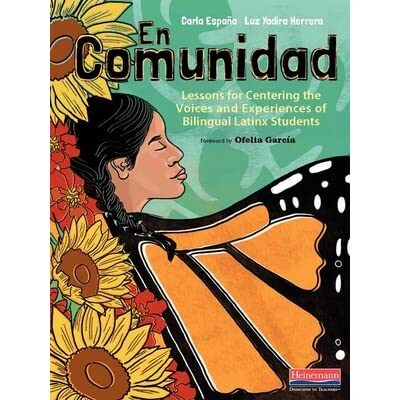
About Carla España
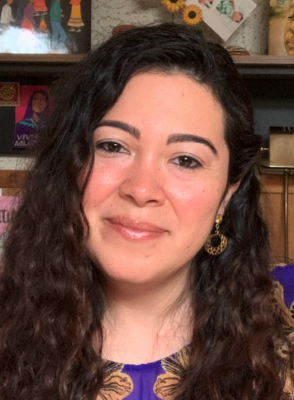 Carla España, Ph.D. is a New York-based educator and author from Chile. Dr. España’s teaching journey began with bilingual and multilingual middle grade students in Harlem, NY. She has partnered with K-12 schools across the United States, Chile, Colombia, and Mexico for curriculum development and literacy workshops. Dr. España has developed courses on teaching methods, bilingual education, children’s literature and foundations of education for teacher preparation programs and language departments. She has taught at Brooklyn College, CUNY; Hunter College, CUNY; Long Island University; and Bank Street Graduate School of Education.
Carla España, Ph.D. is a New York-based educator and author from Chile. Dr. España’s teaching journey began with bilingual and multilingual middle grade students in Harlem, NY. She has partnered with K-12 schools across the United States, Chile, Colombia, and Mexico for curriculum development and literacy workshops. Dr. España has developed courses on teaching methods, bilingual education, children’s literature and foundations of education for teacher preparation programs and language departments. She has taught at Brooklyn College, CUNY; Hunter College, CUNY; Long Island University; and Bank Street Graduate School of Education.
She is the co-founder of the En Comunidad Collective (encomunidadcollective.com) and co-author of En Comunidad: Lessons for Centering the Voices and Experiences of Bilingual Latinx Students with Dr. Luz Yadira Herrera. Find her on Twitter @ProfesoraEspana.

